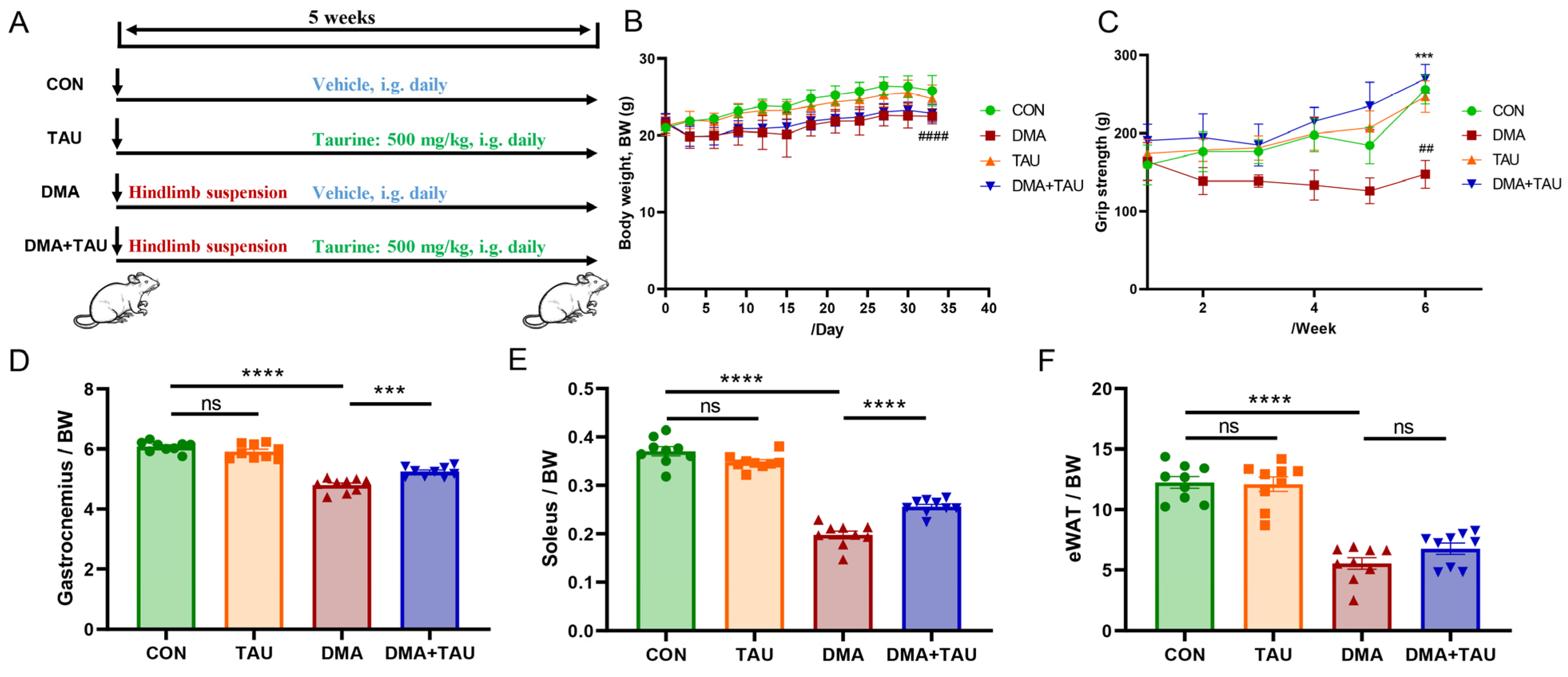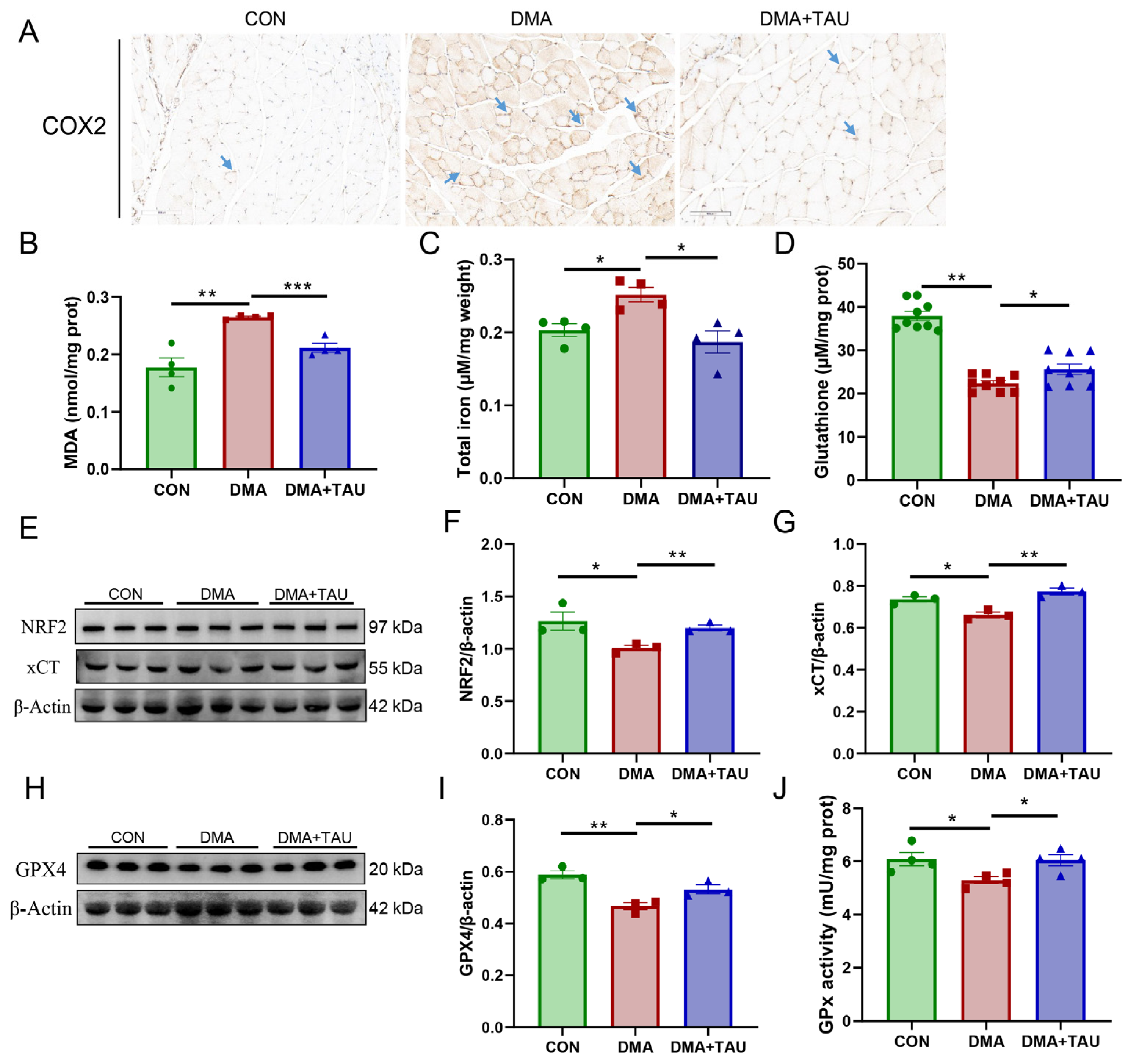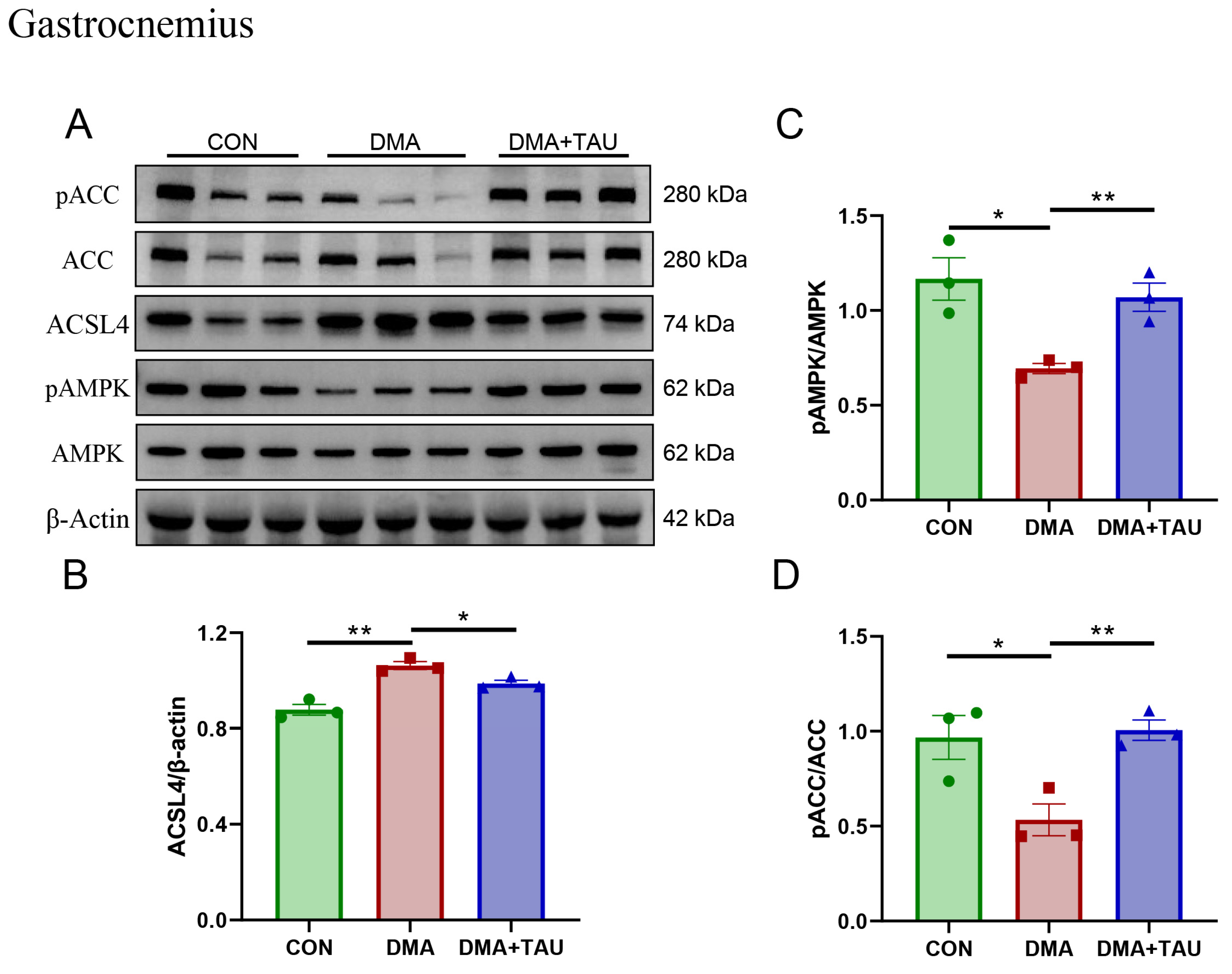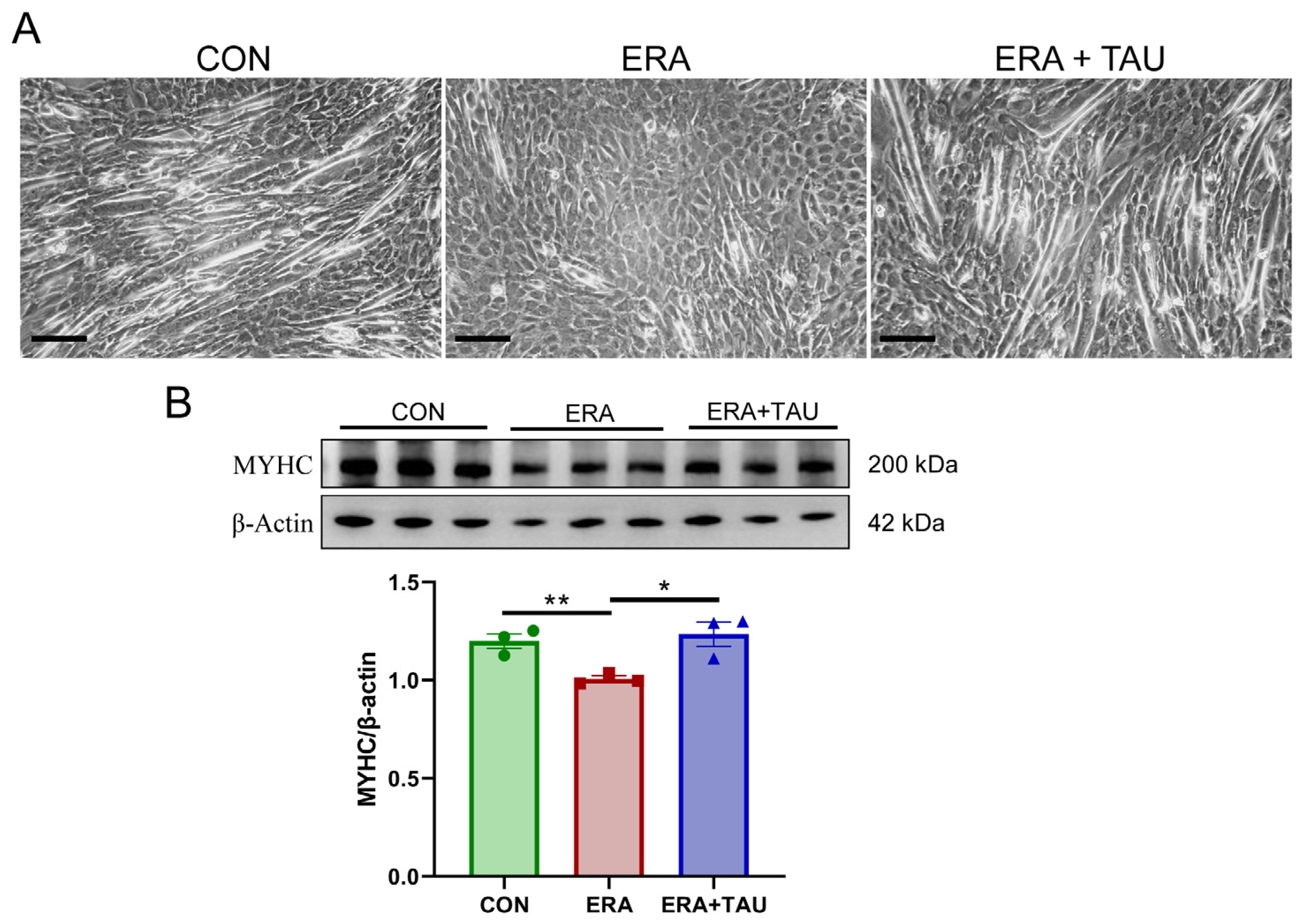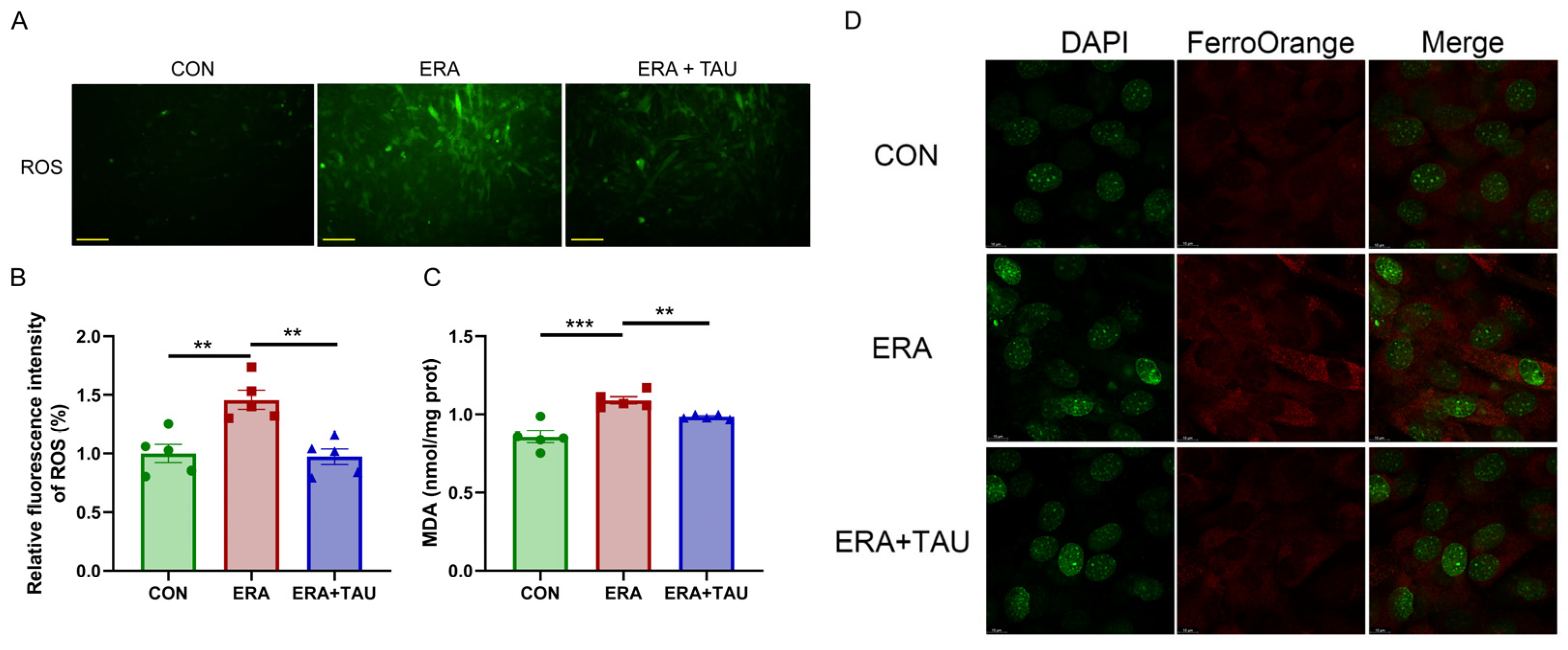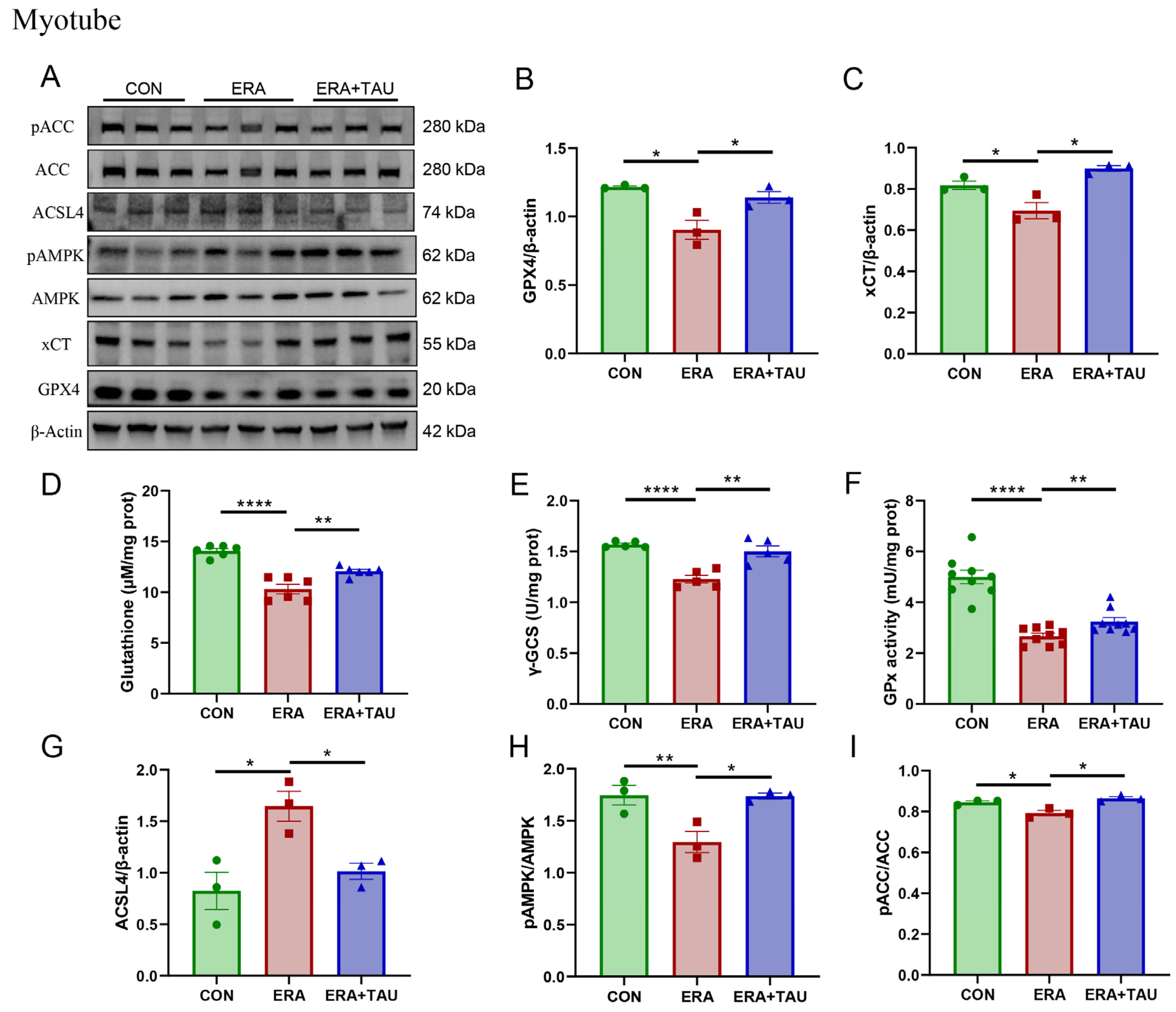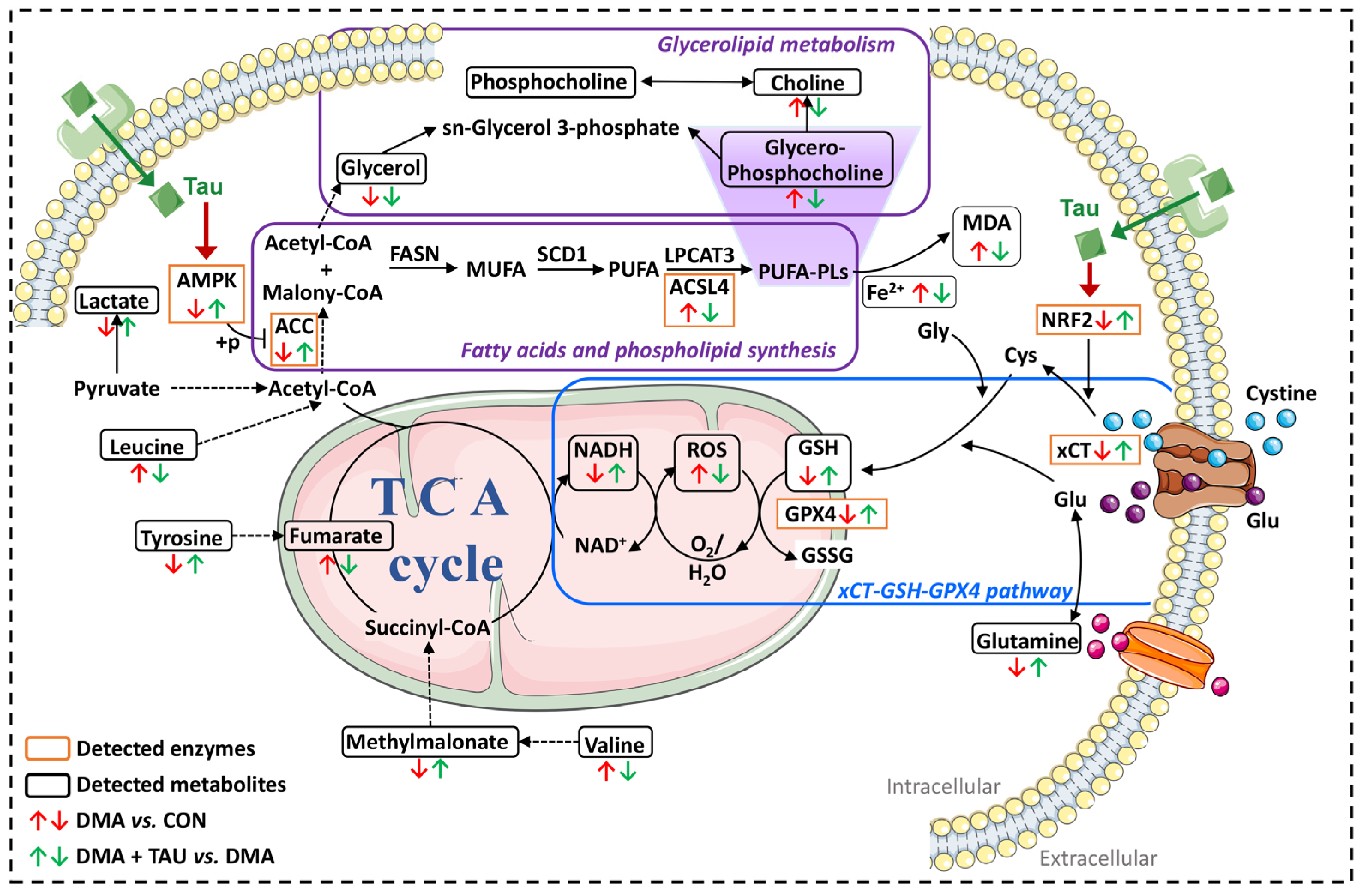1. Introduction
Skeletal muscle, the largest organ in the human body, plays a vital role in maintaining posture, physical activity, thermogenesis, and metabolic regulation [
1]. Skeletal muscle atrophy, characterized by a significant loss of muscle mass and a decrease in myofiber cross-sectional area, can result from genetic mutations, aging, immobilization or disuse, cancer, and other pathological conditions [
2,
3,
4,
5]. In particular, disuse muscle atrophy (DMA) results from extended inactivity and is associated with multiple cellular stress responses, including oxidative stress, mitochondrial dysfunction, inflammation, impaired autophagy, and apoptosis [
6,
7]. Apoptosis has long been recognized as a significant contributor to DMA, with studies reporting the activation of caspase-3 and mitochondrial-mediated apoptotic signaling in skeletal muscle following hindlimb unloading or immobilization [
8,
9]. However, apoptosis alone does not fully account for the underlying mechanisms of DMA, and emerging evidence suggests that alternative forms of regulated cell death, particularly ferroptosis, may play an underappreciated role in DMA pathogenesis [
10,
11].
Ferroptosis, characterized by iron-dependent lipid peroxidation, has recently been implicated in various muscle-wasting conditions associated with aging, cisplatin treatment, and sepsis [
10]. The xCT-glutathione (GSH)-GPX4 axis plays a central role in antioxidant defense, mediating cystine uptake for GSH synthesis and enabling GPX4 to detoxify lipid peroxides [
12,
13,
14]. Concurrently, the AMPK-ACC-ACSL4 pathway regulates lipid metabolism and ferroptosis sensitivity by modulating the availability of polyunsaturated phospholipids (PUFA-PLs), which are susceptible to peroxidation [
15,
16]. While both pathways are well characterized in other biological contexts, their combined role in the progression of DMA has not been fully elucidated. Investigating these pathways together may reveal whether ferroptosis contributes to skeletal muscle degradation via dual impairments in redox balance and lipid metabolic regulation, thereby addressing a critical gap in current knowledge.
Taurine, a naturally occurring β-sulfonic acid, is abundant in excitable tissues and is commonly found in energy drinks, fish, and meat [
17]. It has multiple biological functions including antioxidant and anti-inflammatory effects, and it has been shown to attenuate skeletal muscle atrophy [
18,
19,
20,
21]. Our previous studies have shown that taurine alleviates cisplatin-induced myotube atrophy and ferroptosis-impaired myoblasts [
22,
23], suggesting a potential novel mechanism for its protective effects in muscle disorders. However, the mechanistic effects of taurine on ferroptosis and associated metabolic pathways in the context of DMA remain unclear.
We thus hypothesize that taurine alleviates DMA by inhibiting ferroptosis through regulation of the xCT-GSH-GPX4 and AMPK-ACC-ACSL4 signaling pathways. Using in vivo hindlimb suspension and in vitro C2C12 myotube models, combined with NMR-based metabolomic analysis and molecular assays, this study aims to elucidate the modulatory effects of taurine and provide mechanistic insight into targeting ferroptosis for muscle preservation.
2. Materials and Methods
2.1. Reagents and Instruments
The following reagents and equipment were used in this study: taurine (T0625, Sigma-Aldrich, Shanghai, China), erastin (HY-15763, MedChemExpress, Shanghai, China), methanol (80080418, AR, SinoPharm, Beijing, China), chloroform (10006818, AR, SinoPharm, Beijing, China), and D2O and TSP (Qingdao Tenglong Microwave Technology Co., Ltd., Qingdao, China). Assay kits included MDA (BC0025, Solarbio, Beijing, China), iron assay kit (A039-2-1, Nanjing Jiancheng, Nanjing, China), BCA (LabLead), ROS (E004-1-1, Nanjing Jiancheng Bioengineering Institute, Nanjing, China), GSH (A006-2-1, Nanjing Jiancheng Bioengineering Institute, Nanjing, China), γ-GCS (A091-1-1, Nanjing Jiancheng Bioengineering Institute, Nanjing, China), and GPx (S0058, Beyotime, Shanghai, China). Additional materials and equipment included FerroOrange (F374, Dojindo, Shanghai, China), an ultrapure water system (Milli-Q, Darmstadt, Germany), a fluorescence microscope (Motic, Xiamen, China), an ultra-high-resolution confocal laser microscope (Leica, Wetzlar, Germany), a Bruker Avance III HD 850 MHz spectrometer (Bruker, München, Germany), a multimode microplate reader (BioTek, Winooski, VT, USA), and a freeze-dryer (LGJ-10E, Foring Technology Development, Beijing Co., Ltd., Beijing, China).
2.2. Data Reporting
The chosen sample sizes were similar to those used in the field:
n = 9 samples were used to evaluate the levels of metabolites in tissues [
24];
n = 4–9 samples were used to determine the activity of GPx and γ-GCS [
25,
26];
n = 4–9 samples were used for the determination of total iron content, MDA, and total GSH [
27,
28,
29];
n = 3 samples were used for the assessment of gastrocnemius muscle contractility [
30]; and
n = 3 samples were used to determine the expression levels and phosphorylation levels of a specific protein [
31]. No statistical methods were used to predetermine the sample size. Each experiment was designed and performed along with proper controls, and samples for comparison were collected and analyzed under the same conditions. Randomization was applied where applicable. For NMR analysis, samples were processed and analyzed in random order. In the animal study, mice were randomly allocated into four groups using computer-generated random numbers. For in vitro assays, cells were seeded and assigned to treatment groups in parallel using random assignment. Randomization was not performed in specific technical workflows (e.g., Western blot), where samples needed to be loaded in a specific order to generate the final figures. Blinding was applied wherever possible. For example, samples, cages, or cell-culture dishes during sample collection and processing were labelled as code names that were later revealed by the individual who picked and treated animals or cells but did not participate in sample collection and processing until assessing the outcome. Similarly, during microscopy data collection and statistical analyses, the fields of view were chosen on a random basis and were often performed by different operators, which prevented potentially biased selection for desired phenotypes.
2.3. Disused Muscle Atrophy Animal Experiment
Male C57BL/6J mice (6–8 weeks old, 20–22 g) were housed in a controlled environment (12 h light/dark cycle, 70 ± 5% relative humidity, 23 ± 2 °C). Following a 3–5-day acclimatization period, the mice were randomly assigned to four groups (
n = 9 per group) according to generated random numbers: Control (CON), Taurine-Controlled (TAU), Disused Muscle Atrophy Model (DMA), and Taurine-Treated (DMA + TAU). A schematic of the study design is shown in
Figure 1A. The protocol of these animal experiments adhered to the guidelines outlined by the China Council on Animal Care and Use and was approved by the Institutional Animal Care and the Animal Committee of Xiamen University (XMULAC20220299).
The disused muscle atrophy animal model was established under the hindlimb suspension procedure described in previous studies [
32,
33]. Briefly, the mice’s tails were carefully secured using medical-grade cotton threads and suspended at an appropriate height to prevent hindlimb contact with the ground, simulating a microgravity-induced unloading condition. Food and water were freely accessible throughout the experiment.
Taurine (500 mg/kg, T0625, Sigma) was administered intragastrically once daily to the TAU and DMA + TAU groups throughout the experimental period. The selected dosage was based on prior studies that demonstrated its efficacy in preserving skeletal muscle integrity under pathological conditions [
34]. Body weight and grip strength were recorded at regular intervals.
After five weeks, a comprehensive evaluation of skeletal muscle strength and functional performance was conducted as described in subsequent sections. Gastrocnemius samples were collected for metabolomics, molecular biology, and histopathological analyses.
2.4. Grip Strength Test
Grip strength was tested using a Grip Strength Measuring (GSM) instrument (47200, Ugo Basile (Varese, Italy)). We placed each mouse on the grid of the instrument so that it naturally gripped the grid. Then, we slowly and horizontally pulled the mouse’s tail backwards until the mouse released the grid. The maximum grip force was recorded, and the test was repeated three times after the mouse had rested sufficiently.
2.5. Assessment of Gastrocnemius Muscle Contractility
The gastrocnemius muscle was carefully dissected and immediately immersed in a Petri dish containing Krebs solution. One end of the muscle was secured to a precision transducer using surgical sutures, while the other was attached to a fixed hook at the base of a chamber filled with a specially formulated physiological saline solution designed to mimic the natural ionic environment of skeletal muscle. This solution contained 10 mM glucose, 2.5 mM CaCl2, 10 mM HEPES buffer, 140 mM NaCl, 5 mM KCl, and 2 mM MgCl2.
The contractility assessment procedure was completed within three minutes, including preparation steps such as exposing the Achilles tendon, gastrocnemius, and soleus muscles. Electrodes were attached to the gastrocnemius muscle to initiate contraction testing. The maximum contractile force (T
max) (
n = 3) was recorded using the BL-420F Biosignal Acquisition and Analysis System (v2.4.0.179, Chengdu Taimeng Software Co., Ltd., Chengdu, China). Muscle fatigue resistance (
n = 3) was evaluated based on the time required for T
max to decrease to half of its initial value (1/2 T
max) [
35].
Following the assessments, humane euthanasia was performed via cervical dislocation. The gastrocnemius muscle was immediately dissected and snap-frozen in liquid nitrogen to ensure protocol uniformity and procedural consistency across all experimental groups.
2.6. Histopathology and Immunohistochemistry
The gastrocnemius muscle samples were fixed in 4% paraformaldehyde for 24 h, followed by graded ethanol dehydration and embedding in a paraffin matrix for sectioning into 5 μm thick slices. The sections were stained with hematoxylin and eosin (H&E), and high-resolution images were captured using a light microscope equipped with digital imaging technology. The cross-sectional area of individual muscle fibers was measured using ImageJ software (version 1.51j8), and data visualization was performed using GraphPad Prism.
For immunohistochemistry, the 5 μm thick paraffin sections were deparaffinized in xylene, rehydrated through graded ethanol solutions (100%, 95%, 85%, and 75%), and subjected to antigen retrieval via microwave heating in citrate buffer. Endogenous peroxidase activity was blocked with 3% H2O2 in methanol, followed by serum blocking to reduce nonspecific binding. The sections were then incubated overnight at 4 °C with a COX2-specific primary antibody, followed by incubation with HRP-conjugated goat anti-rat IgG for 1 h at 37 °C. The signal was developed using DAB working solution, and sections were counterstained with hematoxylin.
2.7. Tissue Iron Measurement
The total iron content in the gastrocnemius tissue (n = 4) was quantified using an iron assay kit, following the manufacturer’s protocol. Briefly, tissue samples (100 mg) were homogenized in 900 μL of normal saline using a 65 Hz grinder for 60 s at 4 °C. The homogenate was centrifuged at 10,000× g for 10 min, and the supernatant was mixed with a chromogenic reagent. The mixture was centrifuged again and incubated in a boiling water bath for 5 min. After cooling, the supernatant was transferred to a 96-well plate, and absorbance at 520 nm was measured using a microplate reader (BioTek, Winooski, VT, USA).
2.8. Cell Lines and Cell Culture
Murine C2C12 myoblasts were obtained from the National Biomedical Experimental Cell Resource Bank (Beijing, China). Cells were maintained at 37 °C in high-glucose DMEM supplemented with 10% fetal bovine serum (Biological Industries, Beit HaEmek, Israel), 100 U/mL penicillin, and 100 μg/mL streptomycin under a humidified 5% CO2 atmosphere. When the myoblasts reached 85–90% confluence, differentiation into myotubes was induced by switching to DMEM supplemented with 2% horse serum, 100 U/mL penicillin, and 100 μg/mL streptomycin. The differentiation medium was replaced daily until cell harvest. Taurine (5 mM) was added to the differentiation medium as required. Morphological evaluation was performed using an inverted microscope at 20× magnification.
Differentiated myotubes were assigned to three experimental groups: control (CON)—untreated myotubes; erastin-treated (ERA)—myotubes treated with 2 μM erastin; erastin + taurine (ERA + TAU)—myotubes treated with 2 μM erastin and 5 mM taurine.
2.9. MDA Measurement
Malondialdehyde (MDA) levels were quantified using an MDA assay kit according to the manufacturer’s protocol. Briefly, myotubes or gastrocnemius samples (n = 4–5) were lysed and subjected to ultrasonication (200 W, 3 s pulse-on/10 s pulse-off cycles, repeated 30 times). The lysates were centrifuged at 8000× g for 10 min at 4 °C, and 100 μL of the supernatant was mixed with 400 μL of thiobarbituric acid working solution. The samples were incubated in a 100 °C water bath for 60 min, cooled on ice, and centrifuged again (10,000× g for 10 min). The supernatant was transferred to 96-well plates, and absorbance at 532 nm and 600 nm was measured using a multimode microplate reader. Data were normalized to protein concentration to ensure accuracy.
2.10. Measurement of the Total GSH
The total GSH content in myotubes or gastrocnemius samples (n = 6–9) was measured using the total GSH kit. The extracted solution was added to the samples, followed by vortexing and homogenization. The homogenate was centrifuged at 3500 rpm for 10 min at 4 °C, and the supernatant was collected and mixed with the reactive solution for 5 min. The absorbance at 405 nm was measured to determine the total GSH content, which was subsequently quantified. Data were normalized to protein concentration to ensure accuracy.
2.11. Assessment of GPx Enzyme Activities
Myotubes or gastrocnemius samples (n = 4–9) were lysed in lysis buffer, and the supernatant was collected after centrifugation at 12,000× g for 10 min at 4 °C. A 50 µL aliquot of the supernatant was transferred to a 96-well plate, followed by the addition of 40 µL of a working solution containing NADPH, GSH, and glutathione reductase. The mixture was incubated at room temperature for 15 min, after which 10 µL of a peroxide reagent was added to initiate the reaction. Absorbance at 340 nm was measured immediately using a multimode microplate reader. Measurements were recorded every minute for six time points per sample to determine glutathione peroxidase (GPx) activity. The data were normalized to protein concentration to ensure accuracy.
2.12. Detection of Fe2+ in Myotubes Using Laser Scanning Confocal Microscopy
Myoblasts were seeded on glass-bottom dishes and differentiated for 10 days. Following treatment with specific reagents, myotubes were double-stained with FerroOrange (1 μM) and DAPI (100 μM) in serum-free medium for 30 min at 37 °C in a temperature-controlled incubator. After rinsing with PBS, high-resolution digital images were captured using an ultrahigh-resolution confocal laser microscope (Leica TCS SP8 STED 3X, Leica Microsystems, Wetzlar, Germany) equipped with a 63× oil objective. Image analysis was conducted using LAS X Office software (version _4.7.0, Leica Microsystems, Germany).
2.13. Detection of ROS
To assess intracellular ROS levels, myoblasts were seeded in 6 cm culture dishes. Following differentiation, myotubes (n = 3) were incubated with 5 μM H2DCFDA (dissolved in PBS) for 30 min at 37 °C in a temperature-controlled incubator. After incubation, myotubes were washed with PBS, and representative images from different experimental groups were captured using a fluorescence microscope (Motic, Xiamen, China). Quantitative analysis was performed using ImageJ software (National Institutes of Health, Bethesda, MD, USA) based on three representative images per group.
2.14. Assessment of γ-GCS Enzyme Activities
Myotubes (n = 5) were lysed in normal saline, and the supernatant was collected after centrifugation at 12,000× g for 10 min at 4 °C. A 10 µL aliquot of the supernatant was transferred to 1.5 mL tubes, followed by the addition of 110 µL of working solution. After incubation at 37 °C for 6 min, 10 µL of terminator solution was added and mixed thoroughly. Next, 400 µL of chromogenic agent and stabilizer were added.
The absorbance at 636 nm was immediately measured using a multimode microplate reader. γ-GCS enzyme activity was calculated and normalized to protein concentration to ensure accuracy.
2.15. Western Blotting
Proteins were extracted from myotubes and gastrocnemius muscle samples (biological replicates, n = 3) using RIPA lysis buffer, followed by sonication and centrifugation at 12,000× g for 15 min at 4 °C. Total protein concentration was determined using a BCA protein assay kit, and the supernatant was mixed with SDS loading buffer.
For immunoblotting, 10–30 μg of total protein was separated on 10% SDS-PAGE and transferred to PVDF membranes. Membranes were blocked with 5% BSA for 60 min at room temperature and incubated overnight at 4 °C with the following primary antibodies at their respective working dilutions: MuRF1 (1:1000, 55456-1-AP, Proteintech, Wuhan, China), Atrogin1 (1:1000, 67172-1-Ig, Proteintech, Wuhan, China), NRF2 (1:1000, 20733, Cell Signaling Technology, Danvers, MA, USA), SLC7A11/xCT (1:1000, 26864-1-AP, Proteintech, Wuhan, China), GPX4 (1:1000, 67763-1-Ig, Proteintech, Wuhan, China), ACSL4 (1:1000, 66617-1-Ig, Proteintech, Wuhan, China), Phospho-AMPKα (1:1000, 50081T, Cell Signaling Technology, Danvers, MA, USA), AMPKα (1:1000, 5831T, Cell Signaling Technology, Danvers, MA, USA), Phospho-ACC (1:1000, 11818T, Cell Signaling Technology, Danvers, MA, USA), ACC (1:1000, 3676T, Cell Signaling Technology, Danvers, MA, USA), and β-Actin (1:3000, 20536-1-AP, Proteintech, Wuhan, China). For immunohistochemistry, COX2 antibody was used at 1:200 dilution (HY-P80090, MedChemExpress, Shanghai, China).
After washing, the membranes were incubated with a horseradish peroxidase (HRP)-conjugated secondary antibody for 1 h at room temperature. Protein bands were visualized using an enhanced chemiluminescence (ECL) reagent and captured using ChemiScope Capture (ChemiScope 6000, CLiNX, Shanghai, China). Band intensity was analyzed with ChemiScope Analysis software (Version 7.1, CLiNX, Shanghai, China) and ImageJ (1.51j8, Bethesda, MD, USA) software. Each blot was normalized to a validated internal control (such as β-actin) to account for the loading differences.
2.16. NMR Sample Preparation and Spectra Acquisition
NMR experiments for metabolomics analysis were conducted as previously described [
33]. Briefly, gastrocnemius tissues (biological replicates,
n = 9) were weighed, and approximately 100 mg of each sample was subjected to a solvent mixture of methanol, chloroform, and water (4:4:2.85,
v/
v/
v) to extract aqueous metabolites. Samples were homogenized using a 65 Hz grinder at 4 °C for 60 s. The extracted aqueous phase was dried under nitrogen gas and reconstituted in 550 μL of NMR buffer, consisting of 100% D
2O, 50 mM phosphate buffer, and 0.5 mM TSP (pH 7.4).
The 1H-NMR spectra were acquired using a Bruker Avance III HD 850 MHz spectrometer equipped with a TCI cryoprobe (Bruker BioSpin, Ettlingen, Germany). The standard NOESYGPPR1D pulse sequence [RD-G1-90°-τm-G2-90°-ACQ] was applied to suppress water signals and enhance metabolite detection. The key experimental parameters for 1H-NMR spectra were as follows: mixing time (τm), 10 ms; acquisition time (ACQ), 2.66 s; relaxation delay (RD), 4 s; number of transients, 64; data points, 64 K; spectral width, 15 ppm. All spectra were acquired under optimized conditions to ensure high-resolution metabolite profiling.
The 2D 1H-13C HSQC spectrum was acquired using the hsqcetgpsisp2.2 pulse sequence (Topspin v4.0, Bruker, Ettlingen, Germany). The spectral width in the 1H dimension is 15 ppm, the spectral width in the 13C dimension is 130 ppm, the relaxation delay is 1.5 s, and the sampling data matrix has 1024 × 128 points.
2.17. NMR Spectra Processing
Raw NMR spectral data were preprocessed using MestReNova 9.0 software (Mestrelab Research S.L., Santiago de Compostela, Spain). Resonance assignments were performed using Chenomx NMR Suite 8.3 (Chenomx Inc., Edmonton, Canada), in conjunction with relevant literature references [
32].
The water resonance (δ 4.85–4.75 ppm) was excluded, and the remaining spectral regions (δ 9.50–0.50 ppm) were segmented into 0.001 ppm bins for feature extraction. A data matrix was generated using MATLAB R2014b (MathWorks, Natick, MA, USA).
Peak integrals were normalized to the TSP integral and tissue mass to ensure consistency across samples. Relative metabolite concentrations were calculated based on characteristic peaks and proton counts and are expressed as mean ± standard error of the mean (SEM). This approach enabled accurate quantitative comparisons between experimental groups.
2.18. Univariate and Multivariate Statistical Analyses of NMR Data
Univariate statistical analysis was performed using one-way ANOVA, followed by post hoc tests to assess group differences. Tukey’s Honestly Significant Difference (HSD) test was applied for homoscedastic data, while the Games–Howell test was used for heteroscedastic data. All analyses were conducted using SPSS 22.0 software (IBM, New York, NY, USA). Differential metabolites were identified based on an FDR-adjusted q-value (Benjamini-Hochberg method) < 0.05, ensuring statistical significance.
Multivariate statistical analysis was performed using SIMCA-P 14.1 software (Umetrics, Umeå, Sweden), including unsupervised principal component analysis (PCA) and supervised partial least squares discriminant analysis (PLS-DA). PCA provided an unbiased visualization of sample clustering and variation, while PLS-DA was applied to model group discrimination in a supervised manner. Model reliability and robustness were assessed through 200 permutation tests (n = 200), where R2Y (cum) and Q2Y (cum) values close to 1 indicated a strong predictive model.
Significant metabolites were identified based on a Variable Importance in Projection (VIP) score > 1 from the PLS-DA model. Characteristic metabolites were further determined based on dual selection criteria, requiring an FDR q < 0.05 (from univariate analysis) and VIP > 1 (from PLS-DA). These metabolites were subsequently analyzed to explore their biological significance and contribution to the observed metabolic differences between groups.
2.19. Metabolic Pathway Analysis
The concentrations of identified metabolites across different experimental groups were uploaded to MetaboAnalyst 5.0 software for metabolic pathway analysis. Significantly altered metabolic pathways were identified based on two criteria: p-value < 0.05 (equivalent to −lg p > 1.3) from metabolite set enrichment analysis; Pathway Impact Value (PIV) > 0.2 from pathway topology analysis. This integrated approach ensured the identification of biologically meaningful and statistically significant metabolic pathways associated with group differences.
2.20. General Statistical Analysis
All experimental data are presented as mean ± SEM. One-way ANOVA was used for comparisons involving more than two groups, performed in IBM SPSS Statistics 22.0. For post hoc analysis, Tukey’s HSD test was applied for homoscedastic data, whereas the Games–Howell test was used for heteroscedastic data. Statistical significance was indicated as follows: * p < 0.05, ** p < 0.01, *** p < 0.001, **** p < 0.0001. Data visualization and histogram plotting were conducted using GraphPad Prism 8.0.
4. Discussion
DMA is characterized by progressive loss of muscle mass and function due to reduced limb activity or prolonged immobilization caused by trauma or microgravity [
4]. In this study, we observe for the first time that hindlimb suspension-induced DMA exhibits hallmark features of ferroptosis, including iron accumulation, lipid peroxidation, and decreased expression of xCT and GPX4, as well as reduced GPx activity, implicating ferroptosis as a contributing pathological mechanism in DMA. Importantly, the present study showed that taurine supplementation effectively alleviates DMA, inhibits ferroptosis in DMA, and exerts its protective effect by modulating both glutathione and lipid metabolism, possibly via the xCT-GSH-GPX4 and AMPK-ACC-ACSL4 pathways (
Figure 9).
In addition to conventional strategies such as exercise rehabilitation, nutritional interventions—particularly those involving amino acids and antioxidants—are gaining attention for their potential to mitigate DMA [
41]. Taurine is one of the most abundant free amino acids in mammalian tissues and has demonstrated cytoprotective roles, including antioxidant and anti-inflammatory effects [
21]. Notably, taurine levels increase during the first month after birth in rats, yet they decrease in the skeletal muscle of DMA rats [
19,
42], suggesting its crucial role in maintaining normal skeletal muscle function.
The taurine dosage of 500 mg/kg used in our study was selected based on previous research demonstrating its efficacy in maintaining muscle health, which support the use of this dosage in our study to investigate the effects of taurine on disuse muscle atrophy [
34]. In clinical contexts, taurine has been administered to humans at doses ranging from 1 to 6 g/day for conditions such as cardiovascular disease and diabetes [
43]. While the direct translation of animal dosages to humans can be challenging, the dosage of 6 g/day in human studies suggests that our selected dose in mice is within a reasonable range when considering interspecies differences in pharmacokinetics. Here, we found that taurine supplementation increased the indexes of gastrocnemius and soleus, as well as the cross-sectional area of gastrocnemius and grip strength in DMA mice. Moreover, taurine supplementation effectively downregulated the expression of MuRF1, a key E3 ubiquitin ligase associated with muscle degradation [
36]. These results underscore the therapeutic potential of taurine in preserving muscle mass and function during periods of disuse.
4.1. Taurine Inhibits Ferroptosis in DMA
Chronic disuse exacerbates oxidative stress in skeletal muscle, with the accumulation of ROS recognized as a key driver of muscle atrophy [
44]. A major consequence of oxidative stress is the accumulation of lipid hydroperoxides (LOOH), which is exacerbated under conditions of reduced activity of GPX4, a critical enzyme responsible for the reduction of LOOH [
45]. This mechanism underlies the process of ferroptosis, a distinct, iron-dependent form of regulated cell death driven by lipid peroxidation that has been implicated in several degenerative diseases.
COX2, an enzyme responsible for the oxidation of PUFAs such as arachidonic acid, has also been identified as the key regulatory target in ferroptosis, acting in concert with key antioxidant regulators such as xCT and GPX4 to modulate redox balance and cellular susceptibility to oxidative damage [
13,
46]. In the present study, we observed increased COX2 staining, downregulated expression of xCT and GPX4, increased iron and MDA levels, GSH deficiency, and GPX4 defects in DMA gastrocnemius muscle, all consistent with the characteristics of ferroptosis, strongly suggesting that ferroptosis occurs in DMA.
Our previous work has shown that taurine possesses anti-ferroptotic properties in myoblasts, primarily through its ability to enhance antioxidant defenses [
23]. Here, our results strongly suggest that taurine significantly reverses muscular atrophy and ferroptosis-associated abnormalities in DMA mice. Specifically, taurine reduced iron and MDA accumulation while restoring xCT and GPX4 expression and replenishing GSH levels, highlighting its therapeutic potential in protecting muscle tissue from ferroptotic damage.
Disuse muscle atrophy has classically been attributed to oxidative stress and apoptosis. There is substantial evidence for caspase activation and mitochondrial apoptotic signaling following immobilization or hindlimb suspension, including increased Bax/Bcl-2 ratios and nuclear DNA fragmentation [
8,
9,
47]. These apoptotic responses are particularly pronounced during the early phases of wasting.
However, apoptosis alone does not fully explain the sustained metabolic and structural deterioration observed during chronic muscle unloading. Our results establish ferroptosis as a potential complementary mechanism of cell death in DMA, characterized by iron overload, GSH depletion, and lipid peroxidation, distinct from the caspase-dependent apoptotic cascade. In particular, the ability of taurine to modulate both iron and lipid metabolism suggests its potential utility in targeting this alternative pathway.
Our study identifies ferroptosis as a major contributor to DMA; however, it is important to recognize that multiple cell death pathways, including apoptosis and necroptosis, may operate concurrently or interactively during muscle degeneration. Although apoptosis has been widely implicated in muscle atrophy, our findings highlight a significant role of ferroptosis. Future studies incorporating markers such as cleaved caspase-3 or TUNEL assays are warranted to delineate how ferroptosis and apoptosis may interact or coexist in DMA. Elucidating such pathway crosstalk could reveal synergistic or compensatory mechanisms driving myofiber loss and help to refine targeted therapeutic strategies.
4.2. Taurine Modulates the xCT-GSH-GPX4 Pathway to Improve DMA
Investigating the pathophysiological basis of DMA through metabolic profiling provides valuable insight into therapeutic strategies for muscle preservation [
48]. Our NMR-based metabolomic analysis revealed that taurine modulates key metabolic perturbations, particularly those affecting glutathione and glycerolipid metabolism in the gastrocnemius muscle of DMA mice.
GSH, a major antioxidant in the thiol-redox system, is the preferred substrate of glutathione GPX4, an enzyme essential for neutralizing lipid peroxides. GSH biosynthesis depends on cystine uptake via the x
c− system, whose functional subunit xCT transports cystine into cells, where it is reduced to cysteine and used for GSH production [
14,
49,
50]. Adequate GSH availability enables GPX4 to protect cell membranes from ferroptosis-associated lipid peroxidation, establishing the xCT-GSH-GPX4 axis as a central defense mechanism against ferroptosis [
37,
51,
52].
Upstream of this pathway, the transcription factor NRF2 plays a pivotal role in oxidative homeostasis by inducing the expression of antioxidant proteins, including xCT and GPX4 [
53]. Considering the importance of the xCT-GSH-GPX4 pathway in counteracting ferroptosis, it is easy to understand that NRF2 plays a critical role in mitigating lipid peroxidation and ferroptosis [
53]. Under oxidative stress, NRF2 is translocated to the nucleus after dissociation from KEAP1 and binds to antioxidant response elements (AREs) to initiate transcription of cytoprotective genes [
54]. Notably, NRF2 activation has been shown to attenuate muscle atrophy under various conditions, including aging [
55], dexamethasone [
56], diabetes [
57], and chronic kidney disease [
58].
In this study, DMA was associated with significant down-regulation of NRF2, xCT, and GPX4 expression, decreased enzymatic activities of GPx and γ-GCS, and reduced GSH content, which are hallmarks of ferroptosis-driven oxidative damage. Taurine supplementation effectively restored the above abnormalities and NRF2 signaling, and it regulated the xCT-GSH-GPX4 axis. As a result, taurine improved the glutathione metabolic pathway by regulating GSH biosynthesis and utilization, enhancing antioxidant defenses, and inhibiting ferroptosis, ultimately ameliorating DMA.
4.3. Taurine Regulates the AMPK-ACC-ACSL4 Pathway to Improve DMA
Phospholipid peroxidation is a key driver of ferroptosis, particularly through the oxidation of PUFA-PLs [
15]. Before incorporating into cell membrane phospholipids, fatty acids must first be converted to fatty acyl-CoA, a process catalyzed by the acyl-CoA synthase (ACSL) enzyme family. Among these, ACSL4 preferentially catalyzes PUFA, whereas ACSL3 favors monounsaturated fatty acids (MUFAs) [
16,
59,
60]. Increased ACSL4 activity increases cellular PUFA-PL content, thereby increasing susceptibility to lipid peroxidation and ferroptosis [
16,
61]. In addition, pharmacological inhibition of ACSL4 has been shown to effectively suppress ferroptosis and attenuate acute organ injury, highlighting its therapeutic relevance [
62].
In our study, both DMA gastrocnemius and ERA-treated C2C12 myotubes exhibited significant upregulation of ACSL4 and MDA levels, suggesting an increase in PUFA biosynthesis and enhanced ferroptosis susceptibility. Taurine supplementation significantly downregulated ACSL4 expression in vivo and in vitro, suggesting its role in reducing PUFA accumulation and mitigating lipid peroxidation.
Fatty acid biosynthesis is initiated by the conversion of acetyl-CoA to malonyl-CoA, which is catalyzed by ACC [
40,
63]. AMPK, the cellular energy sensor, directly phosphorylates and inhibits ACC, thereby suppressing fatty acid synthesis and restoring metabolic balance [
64,
65]. Recent studies suggest that ACC is a critical downstream target of AMPK in defending against ferroptosis, where AMPK activation inhibits PUFA synthesis by phosphorylating ACC, effectively reducing lipid peroxidation and ferroptosis [
66].
In both DMA mice and ERA-treated myotubes, we observed reduced phosphorylation of AMPK and ACC, indicating increased fatty acid biosynthesis and increased susceptibility to ferroptosis. Taurine effectively regulated AMPK and ACC phosphorylation, thereby inhibiting PUFAs biosynthesis and attenuating lipid peroxidation. This was further supported by taurine-induced downregulation of ACSL4, reinforcing the regulatory role of taurine in lipid metabolism and ferroptosis resistance.
Taken together, our findings provide novel insights into the potential role of ferroptosis in DMA and underscore the therapeutic effects of taurine. We observed consistent alterations in ferroptosis-related markers, including increased lipid peroxidation, reduced GSH levels, and dysregulated expression of GPX4 and ACSL4. These results suggest that both the xCT-GSH-GPX4 and the AMPK-ACC-ACSL4 pathways are involved in DMA pathogenesis; their functional roles related ferroptosis are listed in
Table S6. The xCT-GSH-GPX4 axis serves as a core antioxidant defense system to facilitate glutathione synthesis and the detoxification of lipid peroxides [
12,
13,
14]. In contrast, the AMPK-ACC-ACSL4 pathway influences ferroptosis susceptibility by modulating PUFA-PL biosynthesis, providing substrates for lipid peroxidation [
15,
16]. This dual focus is justified by the integrated nature of oxidative and lipid metabolic processes in ferroptosis. Taurine’s modulation of both pathways suggests a multifaceted mechanism of action, targeting both upstream redox regulation and downstream lipid susceptibility. Future studies using genetic or pharmacological inhibition are necessary to validate the interactions and evaluate their potential therapeutic applications in DMA.
Although this study focused primarily on the role of AMPK signaling in lipid metabolism and ferroptosis regulation, it is important to recognize that AMPK also has a well-established role in promoting glucose uptake by enhancing GLUT4 translocation and increasing insulin sensitivity in skeletal muscle. Although we did not assess glucose uptake or blood glucose levels in this study, it is conceivable that taurine-related AMPK regulation may have additional metabolic effects beyond lipid metabolism. Future studies are warranted to evaluate whether taurine supplementation improves glucose homeostasis or alters muscle glucose utilization in the context of disuse muscle atrophy, thereby furthering our understanding of its systemic metabolic benefits.
4.4. Prospects and Limitations of the Regulatory Mechanism of Taurine on DMA
While taurine is widely recognized for its antioxidant capacity, our findings suggest that its protective effects in DMA are not solely attributable to general redox modulation. Ferroptosis inhibition involves specific molecular events, such as the suppression of iron accumulation, the prevention of lipid peroxidation, and the modulation of unsaturated fatty acid synthesis, which extend beyond classical antioxidant functions. In this study, taurine was found to increase NRF2 and its downstream targets (GPX4, xCT), which enhance GSH synthesis and antioxidant defense. Taurine also regulates AMPK, which downregulates ACC phosphorylation and reduces the expression of ACSL4, which limits the biosynthesis of polyunsaturated fatty acids and the availability of lipid peroxide substrates. These dual actions—enhancing antioxidant defenses and modulating lipid metabolism—highlight an anti-ferroptotic effect that is distinct yet synergistic with the classical antioxidant role of taurine. Future mechanistic studies using ferroptosis-specifical inhibitors or genetic knockdown models may further elucidate these effects.
It is important to acknowledge several limitations of our study. First, the lack of spontaneous locomotor activity assessments limits the ability to fully interpret taurine’s impact on overall organismal function. Incorporating such behavioral measures, along with electromyography (EMG), in future studies will enable a more comprehensive evaluation of systemic functional outcomes under conditions of muscle disuse and therapeutic intervention. Second, the absence of a classical ferroptosis inhibitor (e.g., ferrostatin-1) as a positive control weakens the mechanistic evidence implicating ferroptosis as a primary contributor to DMA. Future investigations should include such controls to rigorously validate the role of ferroptosis in this context. Third, our study did not assess the long-term effects of taurine intervention, nor did it address its translational applicability to human populations, particularly considering potential sex- and age-related physiological differences. Future investigations should incorporate both male and female subjects to evaluate sex-specific responses and better inform the clinical relevance of taurine as a therapeutic intervention for DMA. Fourth, while our NMR-based metabolomics approach identified several key metabolites associated with muscle atrophy, we were unable to include LC-MS/MS-based independent validation in the current study due to the insufficient number of remaining samples. We acknowledge the importance of confirming metabolite identification using such techniques. Future work should aim to confirm the identified metabolites using independent methods to further strengthen our conclusions.
Looking ahead, there are several key areas including optimizing taurine dosing regimens, evaluating long-term safety, and characterizing its pharmacokinetics in human populations that warrant further investigation to translate these findings into clinical practice. Additionally, prospective clinical trials are needed in at-risk groups, such as bedridden elderly patients, individuals with prolonged postoperative immobilization, and astronauts experiencing microgravity, to evaluate the efficacy, tolerability, and therapeutic potential of taurine in real-world scenarios of disuse muscle atrophy. Specifically, for patients undergoing prolonged bed rest, taurine supplementation may help attenuate disuse-induced muscle atrophy, thereby supporting faster recovery and rehabilitation. In spaceflight settings, taurine could aid in preserving muscle mass and function under microgravity, offering a feasible countermeasure to muscle deconditioning for astronauts during long-duration missions. Moreover, given the prevalence of age-related sarcopenia, taurine may represent a cost-effective and well-tolerated intervention to mitigate muscle loss in elderly individuals, thereby improving mobility and quality of life. Future clinical trials are warranted to evaluate the efficacy, safety, and optimal dosing strategies of taurine in these diverse populations.
